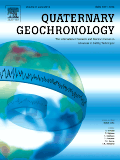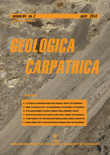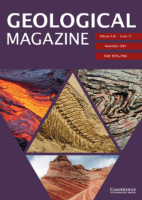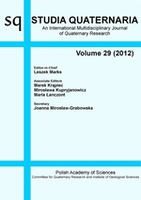
Quaternary Geochronology
Scope & Guideline
Advancing Geochronological Insights of the Quaternary.
Introduction
Aims and Scopes
- Luminescence Dating Techniques:
The journal extensively covers advancements in luminescence dating methods, including Optically Stimulated Luminescence (OSL) and Infrared Stimulated Luminescence (IRSL), which are crucial for establishing the age of Quaternary sediments. - Cosmogenic Nuclide Dating:
Research in this journal addresses the application of cosmogenic nuclides for dating geological features and sedimentary processes, providing insights into surface exposure ages and landscape evolution. - Electron Spin Resonance (ESR) Dating:
ESR dating studies are frequently published, focusing on the dating of various materials including quartz and tooth enamel, which enhances the chronological framework of human and environmental history. - Radiocarbon Dating:
The journal includes significant contributions to radiocarbon dating methodologies, particularly in the context of calibrating and interpreting radiocarbon data in various sedimentary contexts. - Bayesian Age Modeling:
Bayesian approaches to age modeling are increasingly featured, helping to refine uncertainties in chronological frameworks using existing data from multiple dating methods.
Trending and Emerging
- High-Resolution Luminescence Dating:
There is an increasing emphasis on high-resolution luminescence dating techniques, which allow for more precise chronological frameworks in sediment records, particularly in paleoenvironmental studies. - Integration of Multi-Method Approaches:
The trend towards integrating multiple dating methods, such as combining luminescence with radiocarbon and cosmogenic techniques, is gaining traction, enhancing the robustness of age estimates and interpretations. - Applications of Machine Learning in Dating:
Emerging applications of machine learning and statistical methods to improve age modeling and data interpretation are becoming more prominent, reflecting the journal's adaptation to technological advancements. - Environmental Change Studies:
Research focusing on the impacts of climate change and human activities on sedimentation processes and landscape evolution is increasingly featured, underscoring the relevance of geochronology in contemporary environmental science. - Geochronology of Human Evolution:
There is a growing body of work dedicated to the geochronology of human evolution, particularly in relation to archaeological sites and the dating of hominin activities, which highlights the intersection of geology and anthropology.
Declining or Waning
- Traditional Geological Dating Methods:
There appears to be a waning interest in traditional geological dating methods, such as simple stratigraphic correlation or basic radiometric techniques, as researchers increasingly favor more sophisticated approaches like Bayesian modeling and multi-method integrations. - Amino Acid Dating:
The exploration of amino acid dating as a primary dating technique has decreased, possibly due to the challenges associated with its variability and the rise of more reliable methods such as luminescence and ESR. - Paleomagnetic Dating:
While still relevant, the frequency of studies focused solely on paleomagnetic dating has declined, suggesting a possible shift towards integrating paleomagnetic data with other dating methods to enhance chronological resolution. - Tephrochronology:
Interest in tephrochronological studies has diminished, likely as the field moves towards more robust multi-proxy approaches that combine various dating methods for more accurate results.
Similar Journals

GEOLOGICA CARPATHICA
Bridging the Gap Between Theory and Practice in GeologyGEOLOGICA CARPATHICA, with ISSN 1335-0552 and E-ISSN 1336-8052, is a distinguished open access journal published by the Slovak Academy of Sciences Geological Institute, serving as a pivotal platform for the dissemination of research in the field of Geology. Established in 1991 and continuing through 2024, the journal is recognized for its significant contributions to Earth and Planetary Sciences, evidenced by its 2023 Scopus ranking placing it in the second quartile (Q2) within Geology. With an H-index that showcases its impactful publications, GEOLOGICA CARPATHICA is committed to fostering scholarly communication while promoting accessible research, having adopted an open access model since 2009. Located in beautiful Bratislava, Slovakia, this journal aims to engage a global audience of researchers, professionals, and students interested in ecological, geological, and environmental studies, making it a prominent resource for enriching the scientific community's understanding of the Carpathian region and beyond.

QUATERNAIRE
Illuminating the Intricacies of Our Planet's Evolution.QUATERNAIRE is a reputable journal managed by the Société Géologique de France, specializing in the realms of Earth-Surface Processes and Geology. This esteemed publication has been a vital platform for scientific discourse since its inception, presenting compelling research and insights from both fields. With a significant impact in the academic community, it currently holds a Q3 quartile ranking in the 2023 Scopus categories, demonstrating its importance in disseminating knowledge related to geological phenomena. Although QUATERNAIRE does not have an open access model, it ensures that critical research is accessible to a wide audience, enhancing collaboration among geoscientists and environmental researchers. Based in France at 77, Rue Claude-Bernard, Paris F-75005, this journal continues to evolve its publication scope, welcoming contributions that delve into the intricacies of Earth's processes from 1990 to 2024. Researchers, professionals, and students alike will find valuable resources and inspiration within its pages, contributing to a deeper understanding of our planet's past and present.

GEOLOGICAL MAGAZINE
Exploring the Depths of Geological KnowledgeGEOLOGICAL MAGAZINE, published by Cambridge University Press, is a premier journal in the field of geology, renowned for its rich legacy since 1864 and ongoing contributions to Earth and Planetary Sciences. With an impressive Q1 ranking in Geology and a Scopus rank of #70 out of 321 journals, it holds a significant position within the academic community, appealing to researchers, professionals, and students alike. The journal covers a wide array of topics, ensuring a comprehensive platform for the dissemination of cutting-edge geological research. Although it does not offer open access, it remains a vital resource for those seeking to stay abreast of advancements in the field. With an enduring commitment to quality, GEOLOGICAL MAGAZINE stands as an essential outlet for scholarly communication and serves as a catalyst for academic discourse within the geological sciences.

Journal of Earth Science
Connecting global minds through open access geoscience.Journal of Earth Science, published by the China University of Geosciences, Wuhan, is a leading journal in the field of Earth and Planetary Sciences, recognized for its significant contributions to the understanding of geological processes and environmental challenges. With an impressive Q1 ranking among Earth and Planetary Sciences journals and a strong position at Rank #39/195 in Scopus, this journal not only showcases high-quality research but also serves as a crucial platform for disseminating innovative findings, spanning a broad spectrum of topics from geophysics to climate change. The journal adopts an open access model, which enhances the visibility and accessibility of research articles published from 2009 to 2024, thereby facilitating collaboration and knowledge sharing among the global scientific community. With its commitment to advancing geosciences, Journal of Earth Science is invaluable for researchers, professionals, and students alike, eager to stay informed and contribute to ongoing discussions in this dynamic field.

RADIOCARBON
Unveiling the Past: Where Archeology Meets Earth SciencesRADIOCARBON, published by Cambridge University Press, is a premier academic journal that has been pivotal in advancing the fields of Archeology and Earth and Planetary Sciences. With an impressive impact factor placing it in the Q1 category of both disciplines, it ranks 1st out of 413 in Archeology and 6th out of 195 in General Earth and Planetary Sciences. As a trusted source for significant research findings, the journal spans the years from 1980 to 2024, offering a robust archive of scholarly articles. Although it does not currently provide Open Access options, it remains a vital resource for researchers, professionals, and students eager to explore innovative studies and applications in radiocarbon dating and its implications within the broader scientific landscape. The journal’s headquarters in Cambridge, England, solidifies its reputation as a key player in the academic community, fostering rigorous scientific discussions and discoveries.

Geologos
Unlocking the Secrets of Our Planet, One Article at a TimeGeologos is a peer-reviewed journal dedicated to advancing knowledge in the field of Earth and Planetary Sciences. Published by SCIENDO, this Open Access journal has been facilitating unrestricted access to research findings since 2009, ensuring that scholars, professionals, and students can engage with up-to-date scientific discourse without barriers. With an ISSN of 1426-8981 and an E-ISSN of 2080-6574, Geologos is indexed in Scopus, where it currently holds a rank of #111 out of 195 in the General Earth and Planetary Sciences category, reflecting its commendable impact within the discipline. Based in Poland, the journal embraces contributions from international authors, promoting a diverse and inclusive dialogue on topics ranging from geological phenomena to planetary processes. As a Q3 journal in the Earth and Planetary Sciences category, Geologos is committed to enhancing the understanding and appreciation of the Earth's systems, making it an essential resource for those engaged in research and practice within this dynamic field.

Studia Quaternaria
Exploring the forefront of geological research and innovation.Studia Quaternaria is a leading academic journal published by the Polish Academy of Sciences, Institute of Geological Sciences, specializing in the dynamic fields of Earth-Surface Processes and Geology. With an ISSN of 1641-5558 and an E-ISSN of 2300-0384, this journal has been a prominent platform for scholarly discourse since its inception in 2000. Operating under the open-access model, it aims to disseminate high-quality research that is accessible to a global audience. Studia Quaternaria holds a Q3 ranking in both relevant quartiles as of 2023, indicating its commitment to advancing knowledge in its disciplines despite centering in competitive academic environments. With its publications indexed in Scopus, the journal remains a valuable resource for researchers, professionals, and students looking to stay abreast of innovations and discoveries in Earth-Surface Processes and Geology. Encompassing a broad scope of studies, the journal represents an essential contribution to the geological sciences, fostering a deeper understanding of our planet's changes and processes.

Geochronology
Unraveling time's mysteries through innovative geochronological research.Geochronology is a leading journal in the fields of geology, paleontology, and stratigraphy, published by COPERNICUS GESELLSCHAFT MBH in Germany. Since its inception in 2019, this Open Access journal has gained significant recognition, achieving Q1 quartile rankings in its respective categories for 2023, and earning distinctions such as Rank #3 in Earth and Planetary Sciences, Paleontology, and Rank #8 in Stratigraphy on Scopus. With a commitment to disseminating high-quality research, Geochronology provides a platform for innovative studies that explore the intricacies of temporal geological processes and their implications for understanding earth history. Researchers, professionals, and students alike are invited to explore the latest findings and theoretical advances that contribute to the vital discourse in earth sciences, enhancing both academic and practical applications in the field.

GEOLOGICAL QUARTERLY
Unveiling Planetary Insights Through Rigorous Research.GEOLOGICAL QUARTERLY, published by the Polish Geological Institute, is a respected journal in the field of geology, offering insights into Earth and planetary sciences since its inception in 2000. With an ISSN of 1641-7291 and an E-ISSN of 2082-5099, this journal serves as a vital platform for researchers, professionals, and students seeking to expand their knowledge in geological disciplines. The journal is positioned in Q3 within the geology category as of 2023 and ranks #172 out of 321 in Scopus, placing it in the 46th percentile among its peers. Although currently not an open-access publication, GEOLOGICAL QUARTERLY reflects the policy of fostering scientific communication and collaboration by disseminating valuable geological research. Its commitment to publishing original articles, reviews, and technical notes ensures that it plays a significant role in advancing geological science and its applications within the academic community. With its base in Warsaw, Poland, the journal stands as an important resource for anyone engaged in or studying the Earth sciences.

Quaternary
Illuminating the Evolution of Earth and Planetary SciencesQuaternary is a dynamic academic journal that focuses on the intricate and evolving field of Earth and Planetary Sciences, with particular emphasis on Earth-Surface Processes. Published by MDPI, a globally recognized and reputable publisher based in Switzerland, Quaternary has established itself as a vital resource since its inception in 2018. The journal has successfully transitioned to an Open Access model since 2019, ensuring that groundbreaking research is readily accessible to a global audience. With a commendable impact factor reflected in its quartile ranks—Q2 in both Earth and Planetary Sciences (miscellaneous) and Earth-Surface Processes—it ranks comfortably within the top 40% of its field, making it an invaluable platform for sharing innovative research and insights. The journal promotes interdisciplinary collaboration and is committed to advancing our understanding of Quaternary science through high-quality publications that appeal to researchers, professionals, and students alike. Positioned as a significant player in its domain, Quaternary continues to foster discussions that shape the future of Earth sciences.